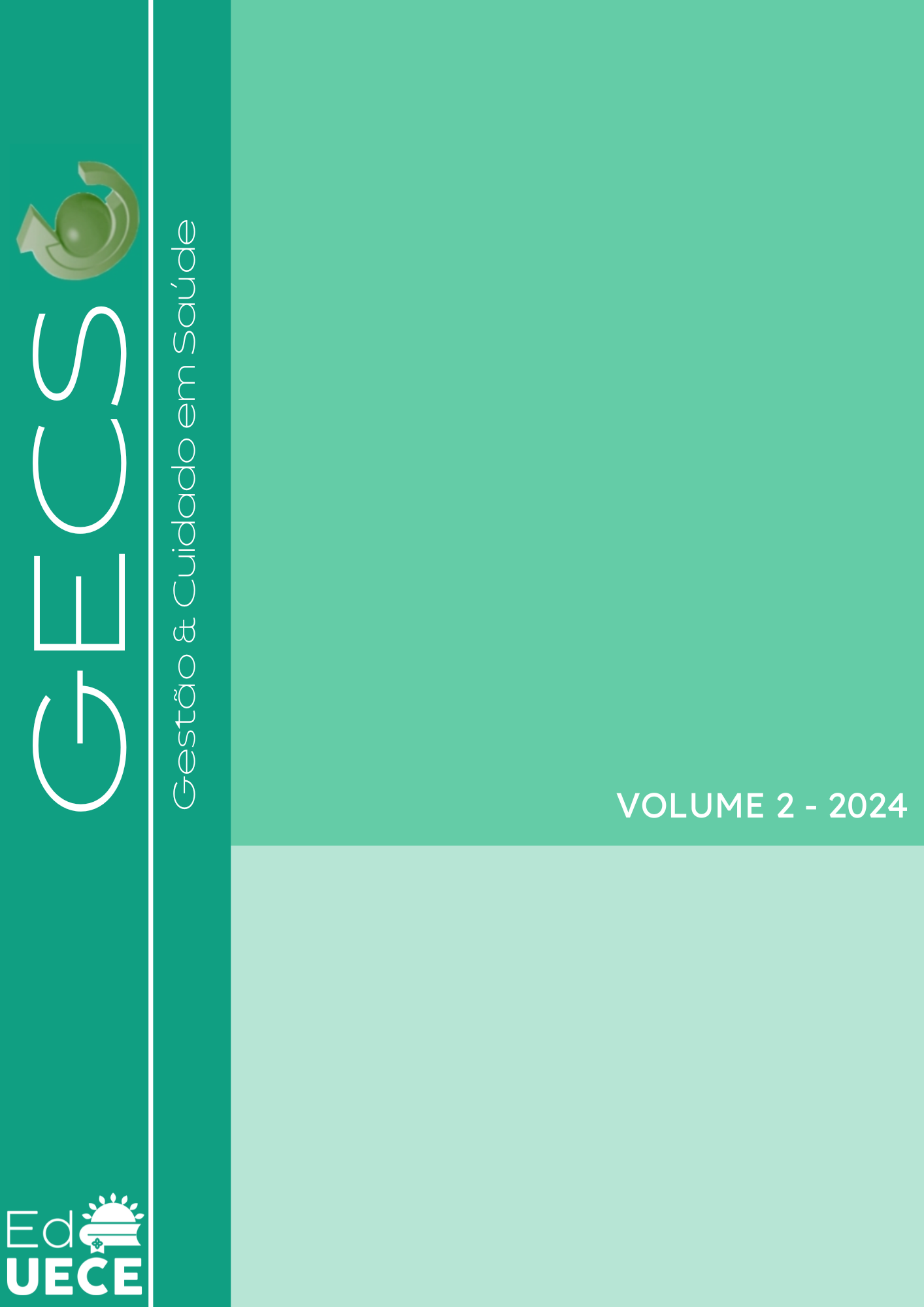Impacto do tempo de exposição às telas no comportamento alimentar de crianças e adolescentes com excesso de peso
DOI:
https://doi.org/10.70368/gecs.v1i2.13674Palavras-chave:
Comportamento Alimentar, Obesidade pediátrica, estado nutricional, tempo de tela, consumo alimentarResumo
O objetivo deste trabalho é avaliar a relação entre o tempo de exposição à tela e o comportamento alimentar de crianças e adolescentes com excesso de peso. Trata-se de um estudo transversal realizado com crianças e adolescentes com excesso de peso de Fortaleza. Foram investigados dados sociodemográficos, clínicos, prática de atividade física, hábitos de exposição às telas e estado nutricional. O Questionário Children’s Eating Behaviour Questionnaire (CEBQ) avaliou o comportamento alimentar. Participaram 82 crianças e adolescentes, sendo 69,5% do sexo feminino. O estado nutricional apresentou associação apenas com a subescala de “sobreingestão emocional” (p = 0,006). O tempo diário de exposição às telas apresentou associação significativa com o comportamento alimentar nas subescalas que refletem interesse pela comida (“resposta à comida”: p = 0,039; “prazer em comer”: p = 0,002; “desejo de beber”: p = 0,01) com maiores médias no grupo que tinha exposição diária excessiva às telas. Além disso, também obtiveram uma pior resposta à saciedade, referido pela subescala “resposta à saciedade” (p = 0,037). O hábito de comer em frente à tela apresentou associação significativa com as subescalas “sobreingestão emocional” (p = 0,019) e “subingestão emocional” (p = 0,014). O comportamento alimentar de crianças e adolescentes com excesso de peso, expostos excessivamente às telas, mostra aumento do interesse pela comida, maior sensibilidade a estímulos alimentares externos, desejo por bebidas açucaradas e menor capacidade de regular o consumo alimentar. Comer em frente às telas e o estado nutricional foram associados ao comportamento alimentar influenciado por fatores de estresse emocional.
Referências
ARUMUGAM, C. T.; SAID, M. A.; FARID, N. D. N. Screen-based media and young children: Review and recommendations. Malaysian Family Physician: the Official Journal of the Academy of Family Physicians of Malaysia, v. 16, n. 2, p. 7, 2021.
BRASIL. Ministério da Saúde. Orientações para a coleta e análise de dados antropométricos em serviços de saúde. Norma Técnica do Sistema de Vigilância Alimentar e Nutricional – SISVAN. Brasília; 2011.
BRASIL. Ministério da Saúde. PROTEJA: Estratégia Nacional para Prevenção e Atenção à Obesidade Infantil: orientações técnicas. Ministério da Saúde, Secretaria de Atenção Primária à Saúde, Departamento de Promoção da Saúde. – Brasília: Ministério da Saúde, 2022a.
BRASIL. Ministério da Saúde. Instrutivo para o cuidado da criança e do adolescente com sobrepeso e obesidade no âmbito da Atenção Primária à Saúde. Universidade do Estado do Rio de Janeiro. – Brasília: Ministério da Saúde, 2022b.
CENTER FOR DISEASE CONTROL AND PREVENTION. Physical Activity Guidelines for Americans. Department of Health and Human Services. Washington; 2008.
FANG, K. et al. Screen time and childhood overweight/obesity: A systematic review and meta‐analysis. Child: care, health and development, v. 45, n. 5, p. 744-753, 2019.
FOLKVORD, F. et al. Promoting fruit and vegetable consumption for childhood obesity prevention. Nutrients, v. 14, n. 1, p. 157, 2021.
FREITAS, A. et al. Appetite-related eating behaviours: an overview of assessment methods, determinants and effects on children’s weight. Annals of Nutrition and Metabolism, v. 73, n. 1, p. 19-29, 2018.
FRUH, S. et al. A practical approach to obesity prevention: Healthy home habits. Journal of the American Association of Nurse Practitioners, v. 33, n. 11, p. 1055-1065, 2021.
JANG, H.; CHO, Y.; OH, H. Recreational screen time and obesity risk in Korean children: a 3-year prospective cohort study. International Journal of Behavioral Nutrition and Physical Activity, v. 21, n. 1, p. 112, 2024.
JUSIENĖ, R. et al. Screen use during meals among young children: Exploration of associated variables. Medicina, v. 55, n. 10, p. 688, 2019.
KIMIM, L. S. et al. Children's eating behaviour: A comparison between normal, overweight and obese children. Annals of Medicine and Surgery, v. 13, n. 84, p. 1-6, 2022.
LACERDA, A. T. et al. Participação de alimentos ultraprocessados na dieta de escolares brasileiros e seus fatores associados. Revista Paulista de Pediatria, v. 38, p. e2019034, 2020.
LI, C. et al. The relationships between screen use and health indicators among infants, toddlers, and preschoolers: a meta-analysis and systematic review. International journal of environmental research and public health, v. 17, n. 19, p. 7324, 2020.
LINDBERG, L. et al. Association of childhood obesity with risk of early all-cause and cause-specific mortality: A Swedish prospective cohort study. PLoS medicine, v. 17, n. 3, p. e1003078, 2020.
LIU, S. et al. Sleep deprivation and central appetite regulation. Nutrients, v. 14, n. 24, p. 5196, 2022.
LOBSTEIN, T. et al. Social disparities in obesity treatment for children age 3–10 years: a systematic review. Obesity Reviews, v. 22, n. 2, p. e13153, 2021.
MACEDO, M. S. et al. A importância da nutrição na prevenção da obesidade infantil. Research, Society and Development, v. 13, n. 6, p. e2913645477-e2913645477, 2024.
MAHMOOD, L. et al. The influence of parental dietary behaviors and practices on children’s eating habits. Nutrients, v. 13, n. 4, p. 1138, 2021.
MARCUS, C.; DANIELSSON, P.; HAGMAN, E. Pediatric obesity—Long‐term consequences and effect of weight loss. Journal of internal medicine, v. 292, n. 6, p. 870-891, 2022.
OLIVEIRA, J. S. et al. ERICA: uso de telas e consumo de refeições e petiscos por adolescentes brasileiros. Revista de Saúde Pública, v. 50, p.7s, 2016.
OTTO, A. F. N.; RIBEIRO, M. A. A escolha alimentar e a complexidade dos sistemas humanos. Revista Brasileira de Psicoterapia, v. 22, n. 1, p. 83-101, 2020.
PASSOS, D. R. Comportamento alimentar de crianças de uma escola privada no município de Pelotas, RS. 2013. Dissertação de Mestrado. Universidade Federal de Pelotas.
SANTANA, P. S.; ALVES, T. C. H. S. Consequências da seletividade alimentar para o estado nutricional na infância: uma revisão narrativa. Research, Society and Development, v. 11, n. 1, p. e52511125248-e52511125248, 2022.
SEHN, A. P. et al. Screen time, sleep duration, leisure physical activity, obesity, and cardiometabolic risk in children and adolescents: A cross-lagged 2-year study. BMC Cardiovascular Disorders, v. 24, n. 1, p. 525, 2024.
SILVA, T. A. et al. Avaliação do comportamento alimentar e da neofobia alimentar em crianças e adolescentes do município de Uberaba, MG. Revista Paulista de Pediatria, v. 39, p. e2019368, 2020.
SIQUIERA, L. G. et al. A relação entre obesidade infantil e tempo de tela. Cuerpo, Cultura y Movimiento, v. 14, n. 1, 2024.
SOCIEDADE BRASILEIRA DE PEDIATRIA. Avaliação Nutricional da Criança e do Adolescente: Manual de Orientação. Departamento Científico de Nutrologia. São Paulo; 2009.
SOCIEDADE BRASILEIRA DE PEDIATRIA. Promoção da Atividade Física na Infância e Adolescência. Manual de Orientação. São Paulo; 2017.
SOUZA, S.; MARQUES, K. C.; REUTER, C. P. Screen time above recommendations in children and adolescents: analysis of the associated nutritional, behavioral and parental factors. Journal of human growth and development, v. 30, n. 3, p. 363-370, 2020.
SUN, X. et al. A 3‐year longitudinal study of the association of physical activity and sedentary behaviours with childhood obesity in China: The childhood obesity study in China mega‐cities. Pediatric Obesity, v. 16, n. 6, p. e12753, 2021.
TAMBALIS, K. D. et al. Screen time and its effect on dietary habits and lifestyle among schoolchildren. Central European journal of public health, v. 28, n. 4, p. 260-266, 2020.
TOSATTI, A. M. et al. Fazer refeições em família tem efeito protetor para a obesidade e bons hábitos alimentares na juventude? Revisão de 2000 a 2016. Revista Brasileira de Saúde Materno Infantil, v. 17, p. 425-434, 2017.
VELOSO, M. G. A.; ALMEIDA, S. G. A influência das mídias eletrônicas na construção dos hábitos alimentares na infância: um panorama do comportamento alimentar infantil na era digital e no contexto familiar. Research, Society and Development, v. 11, n. 9, p. e5611931285-e5611931285, 2022.
VERGA, S. M. P. et al. O sistema familiar buscando a transformação do seu comportamento alimentar diante da obesidade infantil. Revista Brasileira de Enfermagem, v. 75, p. e20210616, 2022.
VIANA, V.; SINDE, S. O comportamento alimentar em crianças: Estudo de validação de um questionário numa amostra portuguesa (CEBQ). Análise Psicológica, v. 26, n. 1, p. 111-120, 2008.
WARDLE, J. et al. Development of the children's eating behaviour questionnaire. The Journal of Child Psychology and Psychiatry and Allied Disciplines, v. 42, n. 7, p. 963-970, 2001.
WORLD HEALTH ORGANIZATION et al. Taking action on childhood obesity. World Health Organization, 2018.
WORLD OBESITY FEDERATION. World Obesity Federation. Atlas 2024. London: World Obesity Federation, 2024.
Downloads
Publicado
Como Citar
Licença
Copyright (c) 2025 Mayra Bezerra Targino , Alane Nogueira Bezerra, Luana Matos de Souza , Eric Wenda Ribeiro Lourenço , Annelise Barreto de Carvalho , Renan Magalhães Montenegro Júnior , Carla Soraya Costa Maia , Synara Cavalcante Lopes

Este trabalho está licenciado sob uma licença Creative Commons Attribution 4.0 International License.
















